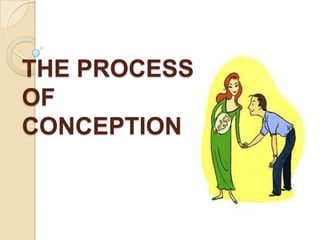The process of conception
- 1. THE PROCESS OF CONCEPTION
- 2. OVAReleased from the Graafian FollicleWill be surrounded by a ring of mucopolysaccharide fluid (Zonapellucida) and a circle of cells (Corona radiata)Zonapellucida and Corona Radiata protects the ova by serving as a buffer against injuryMoves from the ovary to the fallopian tube through the cilia and peristaltic movement of fallopian tube
- 3. SPERMPer ejaculation, 2.5ml semen containing 50-200M spermatozoa is released (ave 400M sperm/ejaculation)Moves through the cervix, uterus, fallopian tube because of their flagella and uterine contractionsUndergoes CAPACITATION (changes in the plasma membrane of the sperm head to reveal sperm binding receptor sites) before penetrating into the corona radiata
- 4. Sperm clusters around coronal cellsWill release HYALURONIDASE (proteolytic enzyme) to dissolve the corona radiataSperm penetrates the cell; cell membrane of ova changes composition to become impenetrable to other sperm
- 5. Sperm and ova fuse carrying 23 pairs of chromosomes eachIf sperm carries X sex chromosome paired with the ovum X chromosome = female zygoteIf sperm carries Y sex chromosome paired with the ovum X chromosome = male zygote
- 6. IMPLANTATIONZygote move from fallopian tube to uterusIt will undergo series of mitotic divisions resulting to a cleavage formation, 1 in every 22 hour, with the cleavage division happening 24 hours after fertilizationOnce it reaches the uterus, zygote is now composed of 32 -50 ball of cell termed as a MORULA
- 7. Another 3-4 days, morula becomes a BLASTOCYST consisting of:An inner cell mass which will become the future embryoTrophoblast which will become the placenta and membranes
- 8. At approx 8-10 days after fertilization, blastocyst attaches to the endometriumSheds off last residues of corona radiata and zonapellucidaBrushes against endometrium (apposition) and settles downA slight vaginal bleeding is experienced during implantation stage because capillaries are ruptured by the implanting trophoblast cells
- 9. EMBRYONIC & FETAL STRUCTURESDECIDUA ŌĆō uterus that has grown thick and vascular3 areasDeciduabasalis ŌĆō lies directly under the embryo (portion where the trophoblast establish communication with maternal blood vessel)
- 10. Deciduacapsularis ŌĆō portion that stretches or encapsulates the surface of the trophoblast
- 11. Deciduavera ŌĆō the remaining portion of the uterine liningCHORIONIC VILLIMiniature villi similar to probing fingers that appear on the 11th or 12th day
- 12. They begin the formation of the placenta
- 13. Consists of a central core of connective tissue and fetal capillariesConsists of 2 layers of trophoblast cells:Syncytiotrophoblast(syncitial layer) ŌĆō produces HCG, somatomammotropin (human placental lactogen), estrogen and progesteroneCytotrophoblast (middle or LanghanŌĆÖs layer) ŌĆō functions in early pregnancy to protect the growing embryo and fetus from infection (eg syphilis)
- 14. PLACENTA15-20CM IN DIAMETER, 2-3 CM DEEP, 400-600g at full term
- 15. Has 25-30 cotyledons (placental compartments that lie on the maternal side)
- 16. Has 2 sides
- 17. Maternal ŌĆō dirty rough
- 18. Fetal ŌĆō shiny smoothFUNCTIONS:Serves to conduct oxygen and nutrients for the fetus
- 19. Secretes endocrine hormones (syncytial cells)
- 20. hCG ŌĆō 1st placental hormone - enusures corpus luteum to continuously produce progesterone and estrogen - supresses maternal immunologic reaction so that placental tissue is not detected and rejected as a foreign substance
- 21. - if fetus is male, stimulates the testes to begin producing testoterone - at 8 week, begins progesterone production, as a result, CL disintegrates and hCG production decreasesESTROGEN (estriol) ŌĆō ŌĆ£hormone of womenŌĆØ - contributes to mammary gland development of mother in preparation for lactation - stimulates uterine growth to accommodate growing fetus
- 22. PROGESTERONE - ŌĆ£Hormone for MothersŌĆØ - necessary to maintain endometrial lining of the uterus during pregnancy - reduces contractility of uterus during pregnancy preventing preterm laborHUMAN PLACENTAL LACTOGEN (human chorionic somatomammotropin) - with both growth promoting and lactogenic (milk producing) properties - promotes mammary gland (breast) growth in preparation for lactation
- 23. - regulates maternal glucose, protein and fat levels so that adequate amounts of these are always available to the fetusAMNIOTIC FLUID800-1200ml
- 24. Slightly alkaline pH 7.2
- 25. Fetal urine adds to its volumeFunctions:Shields fetus against pressure or blow to the motherŌĆÖs abdomen
- 26. Protects fetus from temperature change
- 27. Aids in muscular development because it allows fetusŌĆÖ freedom to move
- 28. Protects the umbilical cord from pressure protecting fetal oxygen supplyHydramnios ŌĆō excessive amniotic fluid - more than 2000ml or pockets of fluid larger than 8cm on UTZOligohydramnios ŌĆō reduction in the amount of amniotic fluid - less than 300ml or no pockets of fluid larger than 1 cm on UTZ
- 29. AMNIOTIC MEMBRANESChorionic membrane ŌĆō the outermost fetal membrane; purpose is to form a sac that contains the amniotic fluid
- 30. Amniotic membrane ŌĆō 2nd membrane lining the chorionic membrane; forms beneath the chorion - produces amniotic fluid - produces phospholipid that initiates the formation of prostaglandins which can cause uterine contractions and may be the trigger that initiates labor
- 31. UMBILICAL CORDFormed from the amnion and chorion
- 32. 53cm (21 in) length; 2 cm thick
- 33. WhartonŌĆÖs jelly ŌĆō a gelatinous mucopolysaccharide that forms the bulk of the umbilical cord giving it its body; prevents pressure on the veins and arteries
- 34. Outer surface is covered with amniotic membrane
- 35. Composed of 1 vein (carrying blood from placental villi to the fetus) and 2 arteries (blood from fetus back to palcentalvilli)Blood flow is 350ml/min at term
- 36. Walls are with smooth muscles, no nerve supply
- 37. Function:
- 38. Transports oxygen and nutrients to the fetus from placenta and return waste products from fetus to placenta





















